INDEX
-
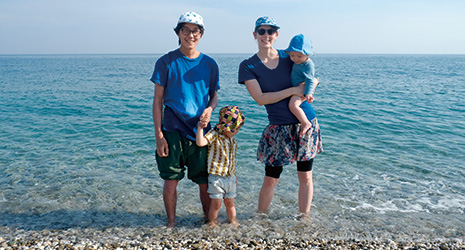
Family life beside the sea:
Sally Hancox (right) and husband Okada Junichi with their children, against the backdrop of the Seto Inland Sea. “Our house is just a stone’s throw from the sea, where you can enjoy swimming in the summer. Our children also enjoy the freedom of playing in the sea and in the mountains every day,” says Hancox. 
Indigo-dyed merchandise drying in the sun
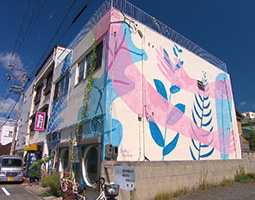
The building housing the indigo dyeing studio AiAii, decorated with murals painted by Hancox 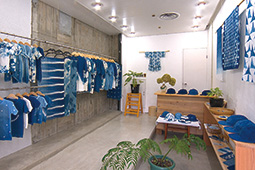
The studio shop with indigo-dyed merchandise created by Hancox and husband Okada Junichi 
Hancox with participants from overseas at an indigo dyeing workshop (Photo pre travel restrictions relating to COVID-19) 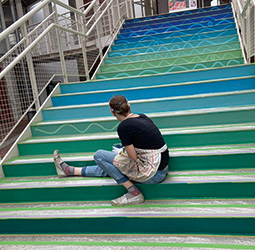
Hancox on the steps of a commercial facility which she painted as a Local Vitalization Cooperator for Sumoto City 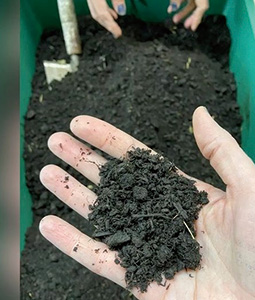
Fermenting indigo leaves to produce the base for the natural dye sukumo 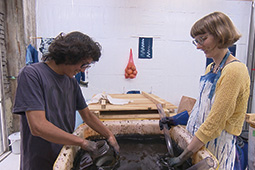
Hancox (right) and husband Okada Junichi making dye with sukumo
November 2021
An English Indigo Dyer on Awaji Island

Sally Hancox (right) and husband Okada Junichi with their children, against the backdrop of the Seto Inland Sea. “Our house is just a stone’s throw from the sea, where you can enjoy swimming in the summer. Our children also enjoy the freedom of playing in the sea and in the mountains every day,” says Hancox.
Sally Hancox from England creates indigo-dyed fabrics on Awaji Island in the Seto Inland Sea while working to promote the island’s charms.

Awaji Island in Hyogo Prefecture is located in the eastern part of the Seto Inland Sea and has an area of 592 square kilometers. It is blessed with a mild climate throughout the year and a peaceful rural landscape.
Sally Hancox moved to Minami Awaji City on Awaji Island while she was pregnant with her first child in 2015. Then in 2019, she moved to the island’s Sumoto City, where she and her husband, Okada Junichi, run the indigo dyeing studio AiAii.

Hancox came to Japan in 2010 on a working holiday after graduating from university in the UK, where she had studied illustration and weaving. She’d always had an interest in different cultures, and spent her time in Osaka studying Japanese while working as an artist, including creating murals. During this time, Hancox married Hyogo Prefecture native Okada, whom she had met at an art event. They began their married life in London, but when they decided to start a family the couple began yearning for a lifestyle of natural green spaces with a view of the ocean. They looked at various potential locations in Okada’s native Japan, before finally settling on Awaji Island.

Hancox resumed her artistic endeavors, this time in the peaceful living environment of Minami Awaji City.
“I was drawn to indigo dyeing partly because I had been creating art with textiles. To me, indigo dyeing evokes Japan more than anything else,” says Hancox. She opened AiAii, an indigo-dyeing studio and store, in 2019, after being accepted by Sumoto City as a Local Vitalization Cooperator, part of a nationwide municipal government program promoting cooperative initiatives within local communities.

AiAii operates out of a renovated fifty-year-old house. The exterior walls are decorated with Hancox’s mural artwork, featuring plants with blue leaves reminiscent of indigo dye. On display in the store are indigo-dyed clothing and accessory merchandise that she made with her husband. Hancox creates her indigo-dyed fabrics using traditional Japanese tie-dyeing techniques, in which cloth is folded or tied and dyed to create unique patterns.

About a year before she opened AiAii, Hancox started to gradually replace the chemical dyes she had been using previously as a material for indigo-dyeing with a natural dye called sukumo produced using the traditional Japanese method of fermenting indigo leaves. She obtains sukumo from across the Onaruto Bridge in Tokushima Prefecture, the home of indigo dyeing, adding lye and other ingredients in her workshop to create a natural dye. (See “Dyeing by Natural Color,” Highlighting Japan, October 2020.)
Hancox promotes the charms of Sumoto City in Japan and abroad by sharing information on social networking services. She also holds indigo dyeing workshops at AiAii.

“We encourage workshop participants to bring their own second-hand clothes to re-dye,” says Hancox. “It’s better for the environment and also creates new value and beauty. Fashion shouldn’t be disposable.”
In the spring of this year (2021), Hancox was able to start growing indigo in a borrowed field in Sumoto City, sowing the seeds then harvesting the leaves at the end of summer. “We realize it’s not going to be easy, but we want to try making sukumo from indigo leaves we grow ourselves,” says Hancox.

The couple’s first harvest of indigo leaves is presently fermenting.
Even if it takes time and effort, Hancox’s dream now is to create “Sumoto Blue” fabrics dyed with indigo grown in Sumoto.

